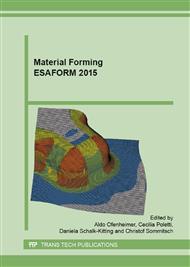[1]
D. Sarker, D.L. Chen, Texture transformation in an extruded magnesium alloy under pressure, Mater Sci Eng A 302 (2001) 37-45.
Google Scholar
[2]
H. Francillette, B. Bacroix, M. Gaspérini, J.L. Béchade, Effect of initial textures on deformation mechanisms and texture evolutions of Zr polycrystals deformed by channel die compression tests, Mater Sci Eng A 234-236 (1997) 974-977.
DOI: 10.1016/s0921-5093(97)00410-3
Google Scholar
[3]
M. Battaini, E.V. Pereloma, C.H.J. Davies, Orientation effect on mechanical properties of commercially pure titanium at room temperature, Metall Mater Trans A 38 (2007) 276-285.
DOI: 10.1007/s11661-006-9040-2
Google Scholar
[4]
R. Gehrmann, M.M. Frommert, G. Gottstein, Texture effects on plastic deformation of magnesium, Mater Sci Eng A 395 (2005) 338-349.
DOI: 10.1016/j.msea.2005.01.002
Google Scholar
[5]
H. Francillette, B. Bacroix, M. Gaspérini, J.L. Béchade, Grain orientation effects in Zr702 polycrystalline samples deformed in channel die compression at room temperature, Acta Mater 46 (1998) 4131-4142.
DOI: 10.1016/s1359-6454(98)00121-9
Google Scholar
[6]
B. Orlans-Joliet, J.H. Driver, F. Montheillet, Plane strain compression of silicon-iron single crystals, Acta Metall Mater (1990) 581-594.
DOI: 10.1016/0956-7151(90)90212-y
Google Scholar
[7]
J.H. Driver, Caractérisation du comportement des monocristaux, F. Moussy and P. Franciosi (Eds. ), Physique et Mécanique de la mise en forme des métaux, Presse du CNRS, IRSID, France 1990, pp.205-215.
DOI: 10.51257/a-v1-m660
Google Scholar
[8]
M.J. Luton, C.M. Sellars, Dynamic recrystallization in nickel and nickel-iron alloys during high temperature deformation, Acta Metall 17 (1969) 1033-1043.
DOI: 10.1016/0001-6160(69)90049-2
Google Scholar
[9]
A. Laasraoui, J. Jonas, Prediction of steel flow stresses at high temperatures and strain rates, Metall Trans A 22 (1991) 1545-1558.
DOI: 10.1007/bf02667368
Google Scholar
[10]
M.R. Barnett, C.H.J. Davies, X. Ma, An analytical constitutive law for twinning dominated flow in magnesium, Scripta Mater 52 (2005) 627-632.
DOI: 10.1016/j.scriptamat.2004.11.022
Google Scholar
[11]
H. Francillette, A. Gavrus, R.A. Lebensohn, A constitutive law for the mechanical behavior of Zr702, J Mater Process Technol 142 (2003) 43-51.
DOI: 10.1016/s0924-0136(03)00439-4
Google Scholar
[12]
J.E. Hockett, D.O. Sherby, Large strain deformation of polycrystalline metals at low homologous temperatures, J Mech Phys Solids 23 (1975) 87-98.
DOI: 10.1016/0022-5096(75)90018-6
Google Scholar
[13]
D. Lloyd, D. Kenny, The structure and properties of some heavily cold worked aluminium alloys, Acta Metall, 28 (1980) 639-649.
DOI: 10.1016/0001-6160(80)90130-3
Google Scholar


